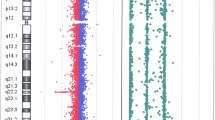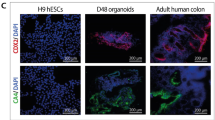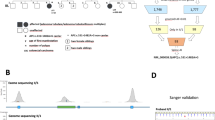Abstract
Familial adenomatous polyposis (FAP) of the colon is characterized by multiple polyps in the intestine and extra-colonic manifestations. Most FAP cases are caused by a germline mutation in the tumor-suppressor gene APC, but some cases of adenomatous polyposis result from germline mutations in MUTYH, POLD1 or POLE. Although sequence analysis of APC by the Sanger method is routinely performed for genetic testing, there remain cases whose mutations are not detected by the analysis. Next-generation sequencing has enabled us to analyze the comprehensive human genome, improving the chance of identifying disease causative variants. In this study, we conducted whole-genome sequencing of a sporadic FAP patient in which we did not find any pathogenic APC mutations by the conventional Sanger sequencing. Whole-genome sequencing and subsequent deep sequencing identified a mosaic mutation of c.3175G>T, p.E1059X in ~12% of his peripheral leukocytes. Additional deep sequencing of his buccal mucosa, hair follicles, non-cancerous mucosa of the stomach and colon disclosed that these tissues harbored the APC mutation at different frequencies. Our data implied that genetic analysis by next-generation sequencing is an effective strategy to identify genetic mosaicism in hereditary diseases.
Similar content being viewed by others
Log in or create a free account to read this content
Gain free access to this article, as well as selected content from this journal and more on nature.com
or
References
Stoffel, E. M. & Kastrinos, F. Familial colorectal cancer, beyond Lynch syndrome. Clin. Gastroenterol. Hepatol. 12, 1059–1068 (2014).
Al-Tassan, N., Chmiel, N. H., Maynard, J., Fleming, N., Livingston, A. L. & Williams, G. T. et al. Inherited variants of MYH associated with somatic G:C–>T:A mutations in colorectal tumors. Nat. Genet. 30, 227–232 (2002).
Palles, C., Cazier, J. B., Howarth, K. M., Domingo, E., Jones, A. M. & Broderick, P. et al. Germline mutations affecting the proofreading domains of POLE and POLD1 predispose to colorectal adenomas and carcinomas. Nat. Genet. 45, 136–144 (2013).
Aretz, S., Stienen, D., Friedrichs, N., Stemmler, S., Uhlhaas, S. & Rahner, N. et al. Somatic APC mosaicism: a frequent cause of familial adenomatous polyposis (FAP). Hum. Mutat. 28, 985–992 (2007).
Farrington, S. M. & Dunlop, M. G. Mosaicism and sporadic familial adenomatous polyposis. Am. J. Hum. Genet. 64, 653–658 (1999).
Hes, F. J., Nielsen, M., Bik, E. C., Konvalinka, D., Wijnen, J. T. & Bakker, E. et al. Somatic APC mosaicism: an underestimated cause of polyposis coli. Gut. 57, 71–76 (2008).
Mongin, C., Coulet, F., Lefevre, J. H., Colas, C., Svrcek, M. & Eyries, M. et al. Unexplained polyposis: a challenge for geneticists, pathologists and gastroenterologists. Clin. Genet. 81, 38–46 (2012).
Johansen Taber, K. A., Dickinson, B. D. & Wilson, M. The promise and challenges of next-generation genome sequencing for clinical care. JAMA Intern. Med. 174, 275–280 (2014).
Biesecker, L. G. Opportunities and challenges for the integration of massively parallel genomic sequencing into clinical practice: lessons from the ClinSeq project. Genet. Med. 14, 393–398 (2012).
Green, R. C., Berg, J. S., Grody, W. W., Kalia, S. S., Korf, B. R. & Martin, C. L. et al. ACMG recommendations for reporting of incidental findings in clinical exome and genome sequencing. Genet. Med. 15, 565–574 (2013).
Li, H. & Durbin, R. Fast and accurate short read alignment with Burrows–Wheeler transform. Bioinformatics 25, 1754–1760 (2009).
Lohmann, D. R. RB1 gene mutations in retinoblastoma. Hum. Mutat. 14, 283–288 (1999).
Sippel, K. C., Fraioli, R. E., Smith, G. D., Schalkoff, M. E., Sutherland, J. & Gallie, B. L. et al. Frequency of somatic and germ-line mosaicism in retinoblastoma: implications for genetic counseling. Am. J. Hum. Genet. 62, 610–619 (1998).
Verhoef, S., Bakker, L., Tempelaars, A. M., Hesseling-Janssen, A. L., Mazurczak, T. & Jozwiak, S. et al. High rate of mosaicism in tuberous sclerosis complex. Am. J. Hum. Genet. 64, 1632–1637 (1999).
Knudsen, A. L., Bisgaard, M. L. & Bulow, S. Attenuated familial adenomatous polyposis (AFAP). A review of the literature. Fam. Cancer. 2, 43–55 (2003).
Nagase, H., Miyoshi, Y., Horii, A., Aoki, T., Ogawa, M. & Utsunomiya, J. et al. Correlation between the location of germ-line mutations in the APC gene and the number of colorectal polyps in familial adenomatous polyposis patients. Cancer Res. 52, 4055–4057 (1992).
Newton, K. F., Mallinson, E. K., Bowen, J., Lalloo, F., Clancy, T. & Hill, J. et al. Genotype-phenotype correlation in colorectal polyposis. Clin. Genet. 81, 521–531 (2012).
Kanter-Smoler, G., Fritzell, K., Rohlin, A., Engwall, Y., Hallberg, B. & Bergman, A. et al. Clinical characterization and the mutation spectrum in Swedish adenomatous polyposis families. BMC Med. 6, 10 (2008).
Iwama, T., Mishima, Y. & Utsunomiya, J. The impact of familial adenomatous polyposis on the tumorigenesis and mortality at the several organs. Its rational treatment. Ann. Surg. 217, 101–108 (1993).
Park, J. G., Park, K. J., Ahn, Y. O., Song, I. S., Choi, K. W. & Moon, H. Y. et al. Risk of gastric cancer among Korean familial adenomatous polyposis patients. Report of three cases. Dis. Colon Rectum 35, 996–998 (1992).
Rohlin, A., Wernersson, J., Engwall, Y., Wiklund, L., Bjork, J. & Nordling, M. Parallel sequencing used in detection of mosaic mutations: comparison with four diagnostic DNA screening techniques. Hum. Mutat. 30, 1012–1020 (2009).
Pagnamenta, A. T., Lise, S., Harrison, V., Stewart, H., Jayawant, S. & Quaghebeur, G. et al. Exome sequencing can detect pathogenic mosaic mutations present at low allele frequencies. J. Hum. Genet. 57, 70–72 (2012).
Acknowledgements
We thank Kiyomi Imamura (The University of Tokyo) for technical help. This work was supported in part by the Grant-in-Aid for Young Scientists to K.Y. (#26860206) from the Japan Society for the Promotion of Science, and Center of Innovation (COI) program from the Japan Science and Technology Agency.
Author information
Authors and Affiliations
Corresponding author
Ethics declarations
Competing interests
The authors declare no conflict of interest.
Additional information
Supplementary Information accompanies the paper on Journal of Human Genetics website
Supplementary information
Rights and permissions
About this article
Cite this article
Yamaguchi, K., Komura, M., Yamaguchi, R. et al. Detection of APC mosaicism by next-generation sequencing in an FAP patient. J Hum Genet 60, 227–231 (2015). https://doi.org/10.1038/jhg.2015.14
Received:
Revised:
Accepted:
Published:
Issue date:
DOI: https://doi.org/10.1038/jhg.2015.14
This article is cited by
-
Use of sanger and next-generation sequencing to screen for mosaic and intronic APC variants in unexplained colorectal polyposis patients
Familial Cancer (2022)
-
Next-generation sequencing with comprehensive bioinformatics analysis facilitates somatic mosaic APC gene mutation detection in patients with familial adenomatous polyposis
BMC Medical Genomics (2019)
-
RNA analysis of cancer predisposing genes in formalin-fixed paraffin-embedded tissue determines aberrant splicing
European Journal of Human Genetics (2018)
-
The genetic basis of colonic adenomatous polyposis syndromes
Hereditary Cancer in Clinical Practice (2017)
-
Longitudinal analysis of colon crypt stem cell dynamics in sulindac treated Familial Adenomatous Polyposis patients
Scientific Reports (2017)



